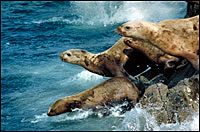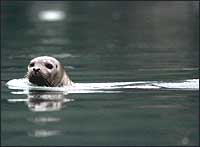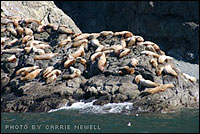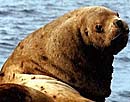



|
Steller Sea Lion - Eumetopias Jubatus Basic Facts  Steller sea lions are the largest members of the Otariid, or "eared seal," family. Female sea lions average seven feet in length and about 600 pounds. Male sea lions, slightly longer at nine feet, weigh more than twice as much as females at an average of 1,500 pounds with "beach masters" reaching up to 2,400 pounds. The otariids in Alaska include three animals: fur seals, California sea lions and Steller sea lions. The eared seals differ from the phocids, or “earless” seals, by having visible external ear flaps and long hind flippers that can be turned under, making travel on land easy. Steller sea lions are the largest members of the Otariid, or "eared seal," family. Female sea lions average seven feet in length and about 600 pounds. Male sea lions, slightly longer at nine feet, weigh more than twice as much as females at an average of 1,500 pounds with "beach masters" reaching up to 2,400 pounds. The otariids in Alaska include three animals: fur seals, California sea lions and Steller sea lions. The eared seals differ from the phocids, or “earless” seals, by having visible external ear flaps and long hind flippers that can be turned under, making travel on land easy.The Steller sea lion is called "seevitchie" by the Aleuts and "sivuch" by the Russians, each translating to "seawolf." The name that the animal now bears comes from George Wilhelm Steller, a naturalist aboard the 1741 Vitus Bering expeditions. Steller thought the creature resembled a lion because the male’s large neck and shoulder region look similar to the mane of a lion. Steller sea lions are light tan to reddish brown in color. Males are visibly larger and appear lighter in color than females. Juveniles are chocolate brown in color and appear in early June. Pups stay dark for their first four to six months and then molt to a lighter color. Top predators include transient orcas and salmon sharks. The camera placed on Chiswell Island tracks the details of predation. During the summer of 2003, live video footage was recorded showing an older transient female orca teaching a younger female and her calf how to feed at the rookery. One method of teaching was to bat puffins into the air with their tails, possibly practicing what it would be like to toss sea lions. A researcher reported on three separate occasions finding the lungs and esophagus of a sea lion in the water, reminiscent of mouse remains that a cat leaves behind. Habitat, Range and Local Sightings  Steller sea lions live in an arc around the north Pacific from central California to Japan. The animals seen in our area of Alaska are from the western stock. Steller sea lions do not migrate, but individuals disperse widely outside of breeding season. Throughout the year in the Seward area, groups of young males cruise the shoreline from the small boat harbor to Lowell Point and back again. It is not unusual to see them in the harbor swimming around the piers and fish-cleaning stations looking for snacks. Steller sea lions live in an arc around the north Pacific from central California to Japan. The animals seen in our area of Alaska are from the western stock. Steller sea lions do not migrate, but individuals disperse widely outside of breeding season. Throughout the year in the Seward area, groups of young males cruise the shoreline from the small boat harbor to Lowell Point and back again. It is not unusual to see them in the harbor swimming around the piers and fish-cleaning stations looking for snacks.Sea lions have numerous haul-outs in the Kenai Fjords. Following the east side of Resurrection Bay, at the north end of Emerald Cove, several large rock islands serve as sea lion haul-outs. From early in the spring season until late July, sea lions use these rocks to dry off and warm up. In August, the sea lions move out to the tip of the cape and become less dependably visible. The entrance to Mary’s Bay on Rugged Island and the south side of Hive Island will sometimes yield sea lions on the rocks below the cliffs. When traveling into Kenai Fjords National Park, the south side of No Name Island (including the separate rocks on both the southwest and southeast ends) often gives the first view of Steller sea lions. Rounding Cape Aialik, look for sea lions hauled out on the rocks that make up the cape. In the Chiswells many of the islands are haulouts. The sloping rock at the southwest arm of Cecil’s Place is a favorite haul-out as well as the back of the arm that faces the Grotto on Natoa Island. Chiswell Island is the only sea lion rookery in our local area. Food and Survival Strategies Steller sea lions are opportunistic marine carnivores. Their most important prey species include: pollock, Atka mackerel, pacific herring, capelin, pacific sandlance, pacific cod, and salmon. Haul-outs and rookeries are mostly located on remote and rocky coasts and islands with easy access to the open sea. Steller sea lions often feed at night, but hunt schooling prey by day in large groups. It is believed that group feeding may help in controlling the movement of schooling fish and prey.  In the years 1976 and 1977, there was a warming period in the Gulf of Alaska waters. This warming lessened the availability of some of the sea lion’s prey, specifically oily fish like sandlance, white capelin, and herring. Sea lions now rely on pollock as a main dietary source. This diet switch may be a contributing factor in the decline of the sea lion as pollock lacks the oil critical to the maintenance of sea lion blubber. In the years 1976 and 1977, there was a warming period in the Gulf of Alaska waters. This warming lessened the availability of some of the sea lion’s prey, specifically oily fish like sandlance, white capelin, and herring. Sea lions now rely on pollock as a main dietary source. This diet switch may be a contributing factor in the decline of the sea lion as pollock lacks the oil critical to the maintenance of sea lion blubber.Reproduction and Young Female Steller sea lions are sexually mature at four to six years of age. Bulls become mature at three to eight years, but cannot defend territory until they are nine or 10 years old. In early May, adult male sea lions haul out on established rookeries to claim their area. A returning bull will attempt to reclaim a spot he has held in past years. Eventually, he will be too old (between 13 to 15 years) to compete and will spend his retirement at a haul-out or possibly hold down some less desirable territory at the rookery edge. The competition for territory consists of aggressive displays: roaring, hissing, and chest-to-chest confrontations with open mouths that sometimes end in severe injury. The victor stays out of the water for as long as a month before any females visit him. Male sea lions fast during this time. In late May or early June, female sea lions arrive at the rookery. Their main objective is to find a good beach on which to give birth. The male with the best birthing territory ends up with the most females. Just 10 to 14 days after giving birth, the female is ready to mate. After fertilization occurs, the embryo develops for a few weeks and then stops. After three to four months, in September or early October, the embryo implants in the uterine wall and resumes growing. This delayed implantation allows the pups to be born at an optimal time. Total gestation time is 11 and one half months.  Pups, usually one per female and weighing 35 to 50 pounds, are born mid-May to mid-July. For five to 13 days the mother stays with the pup; she then leaves the pup alone while she goes out to forage. At 10 to 14 days the pups form groups of their own—sleeping and playing together while the mothers forage. Pups are able to crawl and swim soon after birth but do not enter the water for about four to six weeks. The mother and pup find each other through scent and vocalizations. Pups will sometimes approach other females, but females will not accept pups that are not their own. A pup will continue nursing from the mother even after it starts foraging on its own. Some pups nurse until the mother’s next birth and some until they are three years old. Pups, usually one per female and weighing 35 to 50 pounds, are born mid-May to mid-July. For five to 13 days the mother stays with the pup; she then leaves the pup alone while she goes out to forage. At 10 to 14 days the pups form groups of their own—sleeping and playing together while the mothers forage. Pups are able to crawl and swim soon after birth but do not enter the water for about four to six weeks. The mother and pup find each other through scent and vocalizations. Pups will sometimes approach other females, but females will not accept pups that are not their own. A pup will continue nursing from the mother even after it starts foraging on its own. Some pups nurse until the mother’s next birth and some until they are three years old.Female Steller sea lions can live for 30 years. The males don’t fair as well, likely due to the competition for territory; bulls live to be 15 to 18 years old. Human Connections Alutiiq and Aleut hunters have harvested sea lions for hundreds of years. The skin was used to cover kayaks made of spruce or hemlock wood; the meat was eaten, the intestines made into waterproof garments; the fat provided oil for lamps and was also used as waterproofing. Today, Native Alaskans may still legally harvest sea lions for subsistence purposes. More general information on Kenai Fjords National Park is available at: Kenai Fjords National Park We would like to thank the NPS for the above information. |




 Did You Know?
Did You Know?